Apple is an essential temperate fruit, and its scientific name is Malus pumila. Apple trees are grown worldwide and are one of the most widely cultivated species of the genus Malus. Apple varieties vary in their yield and the final size of the tree, even when grown on the same rootstock. Tree density, spacing, and orchard orientation are essential to ensure that crops make the best use of environmental conditions to maximize productivity. Check out the top 20 steps to boost your Apple fruit yield below.
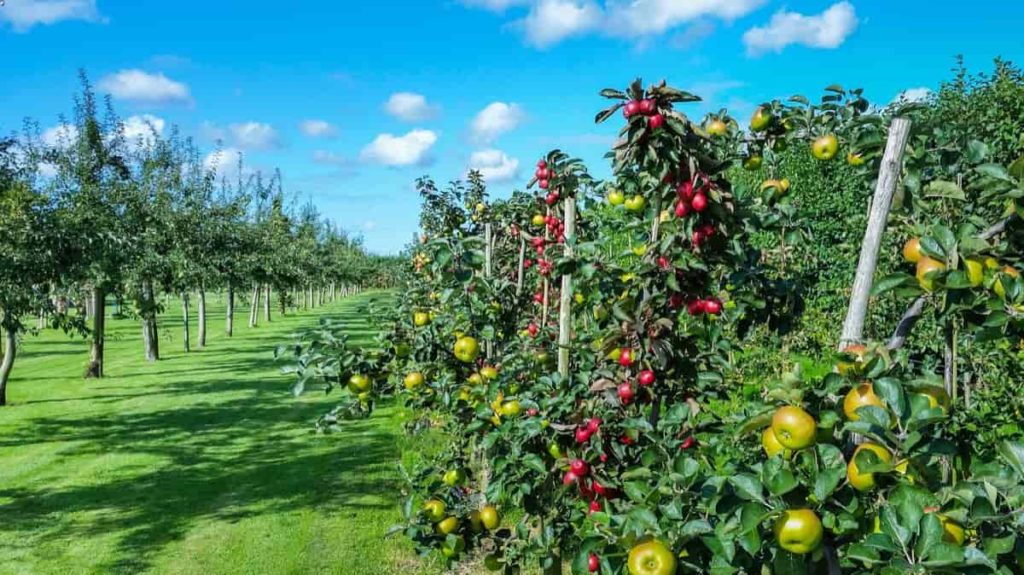
Top 20 steps to boost your Apple fruit yield
Step 1: Site selection is a key factor for crop yield
The success of any crop is directly linked to planning and preparation. The best site faces south, with a slope between 4 and 8%, as operating equipment can be complex on steeper slopes. Deep, well-drained soils are preferred because shallow and poorly drained soils cause root system problems. Irrigation is another consideration when choosing a site.
Step 2: Soil preparation
Apples grow best on well-drained, loamy soil with a depth of 45 cm and a pH level of 5.5-6.5. Apples do not usually grow well near the ocean, where temperatures are mild most of the year. Apples grow best in full sun.
Step 3: Apple variety selection is important to increase yield
Some popular varieties of Apple trees include;
- Honeycrisp Apple Trees
- Fuji Apple Trees
- Gala Apple Trees
- Red Delicious Apple Trees
- Granny Smith Apple Trees
- Pink Lady Apple Trees
- Golden Delicious Apple Trees
- McIntosh Apple Trees
In case you miss this: Custard Apple Gardening, Tips, Ideas, and Techniques.
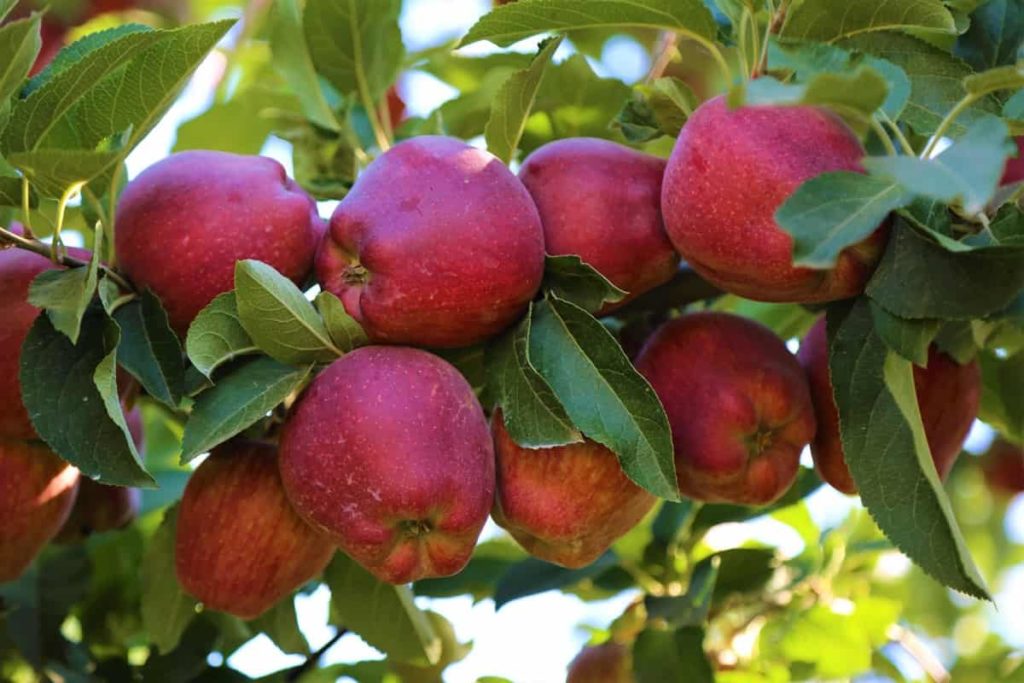
Step 4: Planting tips
Planting distances change based on the variety and level of soil fertility. The critical thing in planting trees is to plant enough pollinators to ensure adequate pollination. Usually, two to three large trees planted at a distance of 10 meters require one pollinator tree or one-row pollinator for two rows of the main plantation. A pollinator tree is planted consecutively after every sixth tree for high-density planting.
The most widely used planting system in Apple farming is the square system. In this system, pollinators are planted after every sixth or ninth tree. Another popular planting system is the rectangular system. Apple orchards are established by planting trees on shapes to prevent soil erosion and reduce its flow in hilly areas.
Step 5: Select planting material to increase Apple production
For Apple cultivation, budding and tongue grafting methods are commonly used. Planting material should be purchased only from registered nurseries, and proper care should be taken while transporting it.
Step 6: Timing and method of planting
Apple planting is usually done in January and February. Before planting, pits of 60 cm are dug for two weeks. Holes are filled with good clay and organic matter. Planting is done by pulling the soil in the middle of the pit and keeping the soil ball at the roots. Loose soil is filled in the rest of the space and lightly pressed to remove air gaps. Seedlings are staked and watered immediately.
Step 7: Regular pruning is necessary to increase yield
Each year, plants should be pruned to get the best harvest, usually summer for espalier, bushes, and pyramids, and trees in summer and winter. The purpose of pruning is to increase the formation of flower buds and prevent excessive growth. In addition, pruning and thinning the crop is very important if farmers want to produce a maximum number of fruits of uniform size. The primary key is to achieve a healthy balance between plant growth and fruiting wood so that the tree has enough energy to produce healthy Apples.
In case you miss this: Pineapple Gardening For Beginners, How To Start
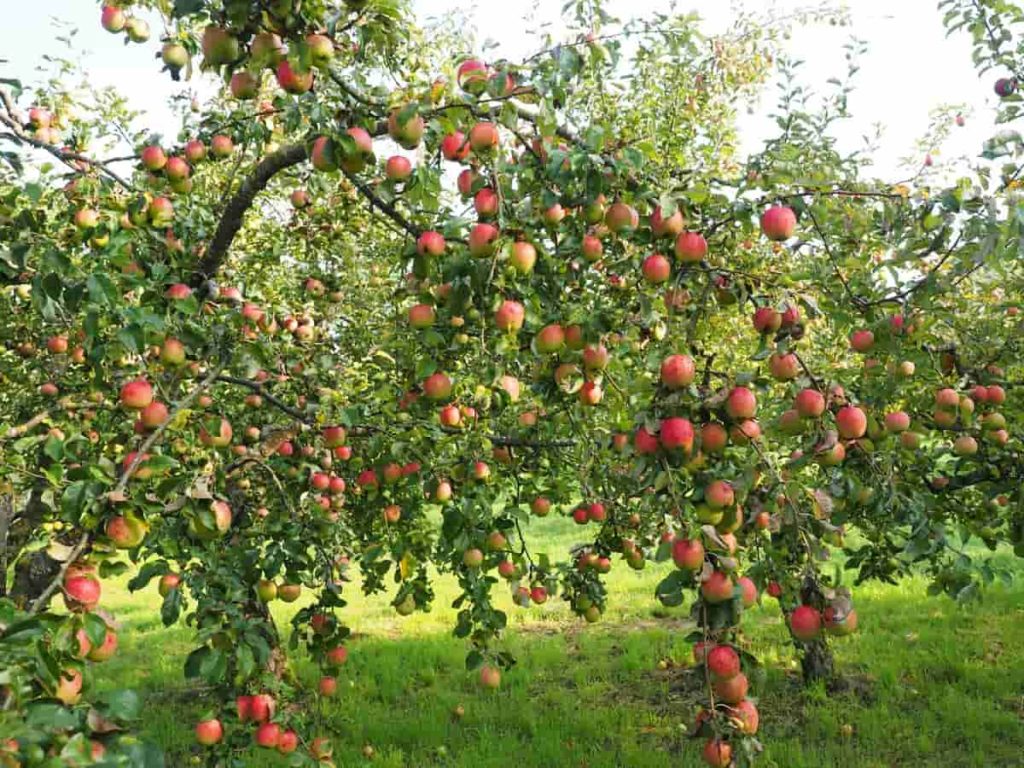
Step 8: Thinning is important for fruit growth
Thinning is one of the primary techniques used to regulate fruit quality. In Apples, the heavy impact is not only the result of small size poor, quality fruit but also sets in the alternative bearing cycle. Properly thinning at the proper stage of fruit development can regulate the harvest and improve the fruit size and quality. Because manual thinning is cumbersome and expensive, chemical thinning is used. Sometimes chemical dilution occurs after lacking calcium, so adequate calcium nutrition must be met after thinning. It is crucial to keep one fruit for every 40 leaves. It keeps the fruit at a distance of about 15-20 cm, and there will be only one fruit per spur.
Step 9: The best fertilizer for Apple trees to increase yields
It requires balanced nutrition to get higher yields. High yield is a function of the number of fruits and the size of the fruit. To get the highest yield of Apples, it is necessary to get the right balance of the number of fruits on the tree. Apple trees need attention every year to maintain the best fruit production. Apple trees consume most of their nutrients in moderation, but they are also high users of potassium and calcium. Potassium and calcium can be applied every year, but other nutrients should only be used when you are deficient.
Step 10: Maintain adequate and balanced tree nutrition
The crop should have all the nutrients available at the desired rate and balance.
- Nitrogen and potassium are key elements in enhancing the growth of twigs and leaves, maximizing flowering, fruit set, and filling, as well as productivity.
- Apple trees use large amounts of potassium each year to produce fruit.
- Phosphorus is important for skin growth and roots, and then for producing a large number of healthy flower clusters and good fruit size.
- Calcium is needed to ensure healthy leaf growth and canopy growth, thus providing a strong platform for high yields.
- Magnesium and manganese also ensure good photosynthetic activity, maintain productive growth and keep the fruit on the tree strong.
Step 11: Supply adequate water
If the fruit is to be propagated at harvest time and grown into high-quality large fruits, it is essential to maintain a proper water supply to the tree during the growing season. Ensure that trees are provided with adequate water and nutrients to maintain cell proliferation and Apple fruit growth. Regularly monitor water requirements and check soil and leaf nutrient levels using vapor transfer calculations or other marketed instruments to measure soil water level.
In case you miss this: Apple Gardening For Beginners, How To Start, FAQs
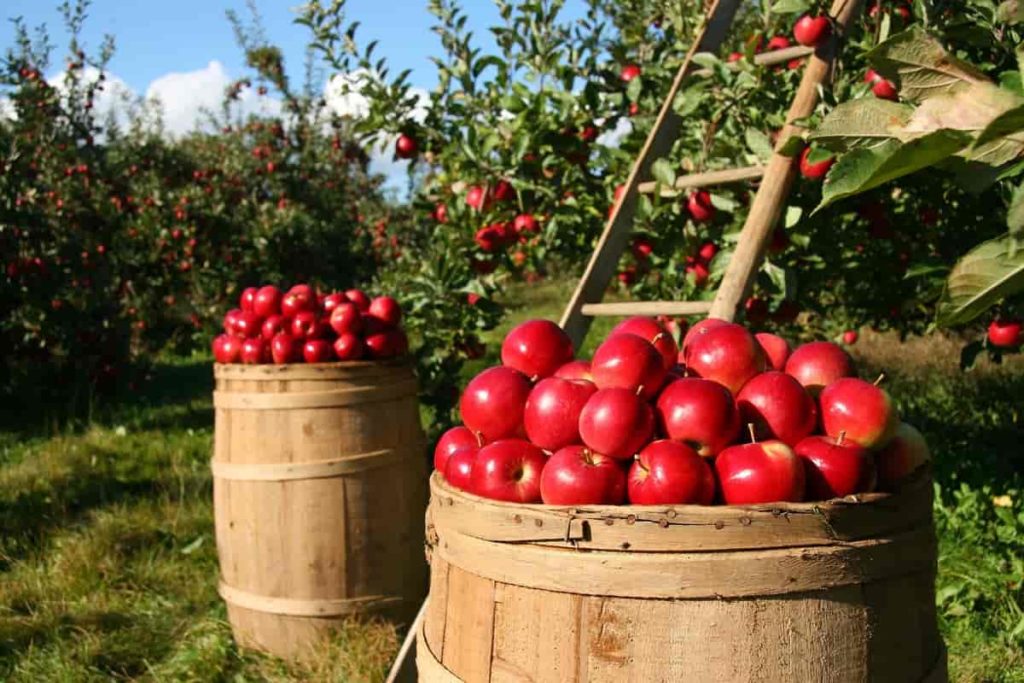
Step 12: Crop management tips
If Apple orchards are profitable, a high proportion (> 80%) of the harvested crop must be of appropriate size, appearance, and quality to obtain the highest available profit. Therefore, it is important to improve all management information to ensure optimal fruit size and quality through harvest time and storage. To achieve these goals;
- Make sure the fruit is set with the right number of seeds.
- Prune and train trees to improve exposure to fruits to light.
- Maintain a proper and balanced supply of water and nutrients to the trees.
- Avoid using crop protection or other sprays that can damage the skin of the fruit. Apply gibberellins spray to improve skin finish.
Step 13: Increase fruit growth and quality
The fruit’s size, organoleptic, and uniformity properties are essential parameters that determine profitability. In addition, in the early stages of fruit development, calcium contributes to the formation of cell walls: its deficiency leads to poor shelf life after harvest.
Step 14: How to protect Apple tree
Here are some precautions you can take to keep your tree healthy;
- Apply fungicide spray on growing trees – This will help reduce the risk of infection from the surrounding juniper, cedars, and Apple trees.
- Remove dead, damaged, or diseased branches – This includes suckers – the shoots that grow from the roots of your tree. Also, you can treat your trees with pesticides to help prevent these diseases.
Step 15: Organic tips to control Apple tree problems
Successful organic fruit growing begins with a varied selection that is naturally resistant to disease. Apples suffer from many serious diseases, such as Apple scabs. In addition, apples are one of the most complex fruits to grow organically because they attract many insects. Pest control strategies can be hard work, and the results can vary from year to year. Pest-specific organic solutions for Apple trees include integrated pest management, the release of beneficial pests, and spraying organically approved pesticides.
Organic control methods include cultural control and spraying products containing paraffinic oil, kaolin clay, or Spinosad. Apply them according to the product label. For cultural control, pick up dropped fruit, get rid of them, and remove all infected Apples by hand before the larvae emerge as adults. Organic methods of controlling Apple maggots include Ditomecius Earth, Pyrethrum products, and Rotenone. As always, apply them according to the product label.
Step 16: Fruit drop in Apple trees
Fruit drop is caused by the competition of fruits growing for nutrients and water. Skin thinning is recommended to avoid the biennial bearing. It is also a major cause of fruit drop. Apples begin to fall from the tree before they are ripe or fully grown. Many factors can trigger early fruit drop: excessive fruit load, excessive summer pruning, pest damage, disease, and extreme weather.
In case you miss this: Apple Tree Growing Tips, Ideas, and Secrets
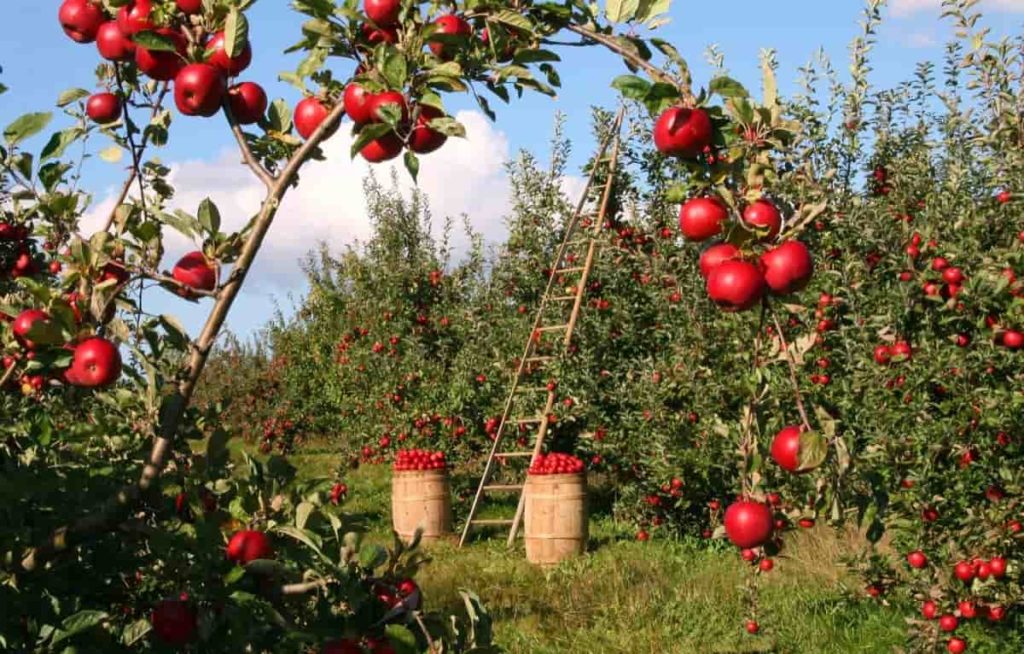
For promoting the ripening process, Ethylene will be helpful and responsible for forming the abscission layer in the fruit stem. Therefore, it is advisable to spray NAA by 15 ppm 20-25 days before harvest to control premature fruit drop.
Step 17: Tips for preventing fruit drop
Thinning the fruit early in the season to reduce the fruit to one or two per cluster will help prevent the fruit from falling. Lack of water can also cause premature fall of Apple fruit, so maintain watering schedule and mulch to retain moisture and control soil temperature. Other causes of fruit drop are more serious. For example, fruits can fall due to an attack by pests or diseases.
For this reason, it is essential to follow a pesticide spray schedule. Be sure to follow the manufacturer’s instructions and not spray when polishing as you do not want to kill bees and other pollen, or you will not get any Apples.
Step 18: How to increase the size of Apple fruit?
Nitrogen and potassium are key elements in enhancing the growth of shoot and leaves, maximizing flowering, fruit set, filling, and production potential. Phosphorus is important for fruit growth and roots and then for producing many healthy flower clusters and good fruit size.
Step 19: Apple tree care
Care means knowing how and where to plant them, how to prune and water them, how to find the symptoms of pests or diseases, and how to harvest. Knowing the proper care of an Apple tree is the difference between a healthy tree that bears good fruit for many years, a mediocre tree that struggles to grow, and an unhealthy tree that does not tolerate it. Practice deep water throughout the summer and fall. This will help your tree roots grow deeper, which will keep them healthy during the colder months.
In case you miss this: Growing Custard Apple in Containers (Sitaphal)
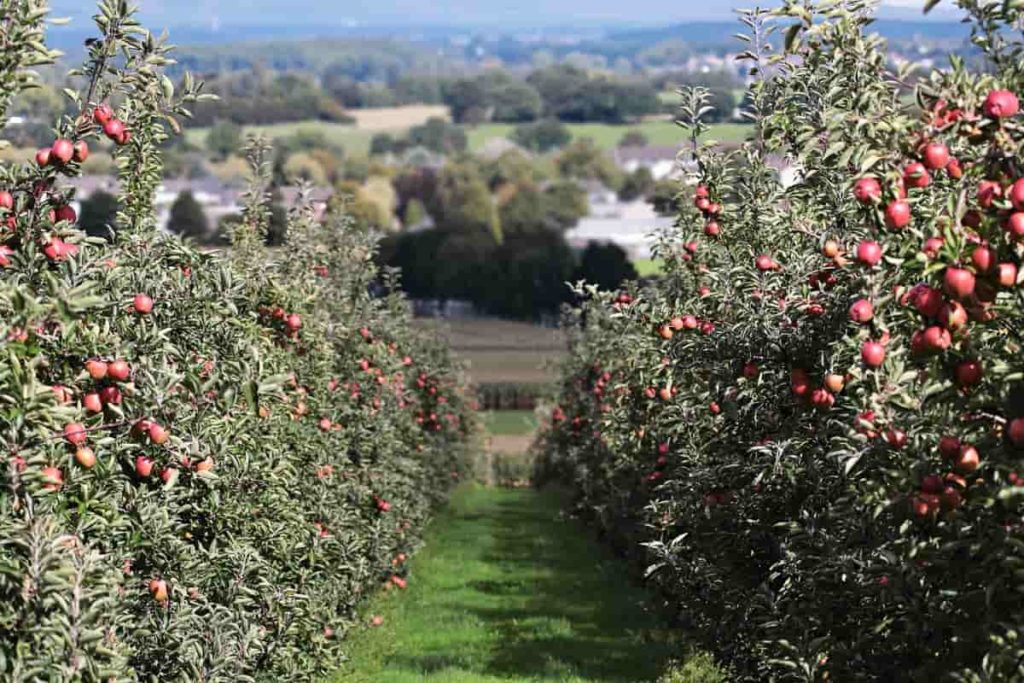
Be sure to add fertilizer even in hot weather, which will enhance your tree’s health during winter. Choosing the type that is resistant to the disease reduces the need for sprays to control the disease, but it does not eliminate the possibility of the disease. If you notice severe pest or disease problems in your Apple tree, it may be necessary to spray fungicide and pesticide on the tree.
Step 20: Harvesting time
Dwarf crops begin to bear fruit in one to three years. Standard varieties begin to bear fruit in five to ten years. Apples are harvested from mid-summer to late autumn. Depending on the type, fruits ripen 100 to 200 days after set. The best way to know if an Apple is ready for harvest is to taste it, choose one, and try it. Also, consider skin color and fruit drops. Apples are usually ready for harvesting when they reach full color. The full color may vary according to the variety. A mature Apple will easily come off the tree.
Lift the Apple and turn it in a rotating motion. It is not necessary to cut the Apple from the stem. Late ripening Apples usually ripen faster than early ripening early and mid-season varieties. As a result, the backyard tree has an excellent yield of about 80-150 fruits per season. However, when Apple trees are grown commercially in Apple orchards, due to sophisticated pollination, fertilization, irrigation, and plant protection methods, they can grow from 400 to 800 (and in some cases more than 12000) fruits in a season.
- Best Liquid Fertilizer for Flowering Plants
- How to Set Up an Efficient Watering System for Home Garden
- How to Mulch Tulip Bulbs: Expert Tips Best Tulip Blooms
- Common Problems with Potted Figs and How to Solve Them
- How to Prevent Flower Drops in Pomegranate Trees: Effective Tips
- How to Boost Ridge Gourd Flowering and Yield: A Beginner’s Guide
- Effective Pollination Techniques for Maximizing Gourds Yield
- Composting Techniques for Manure in Home Gardens
- A Step-by-Step Guide on Propagation Techniques for Jasmine Plants
- How Do I Make My Garden Less Cluttered: A Beginners Guide
- Growing Red Currants at Home for Beginners
- Gardening Techniques in Planting Vegetables
- Where to Place Indoor Plants in Your Home
- How to Grow Tomatoes Organically at Home: A Comprehensive Guide
- Organic Gardening on a Budget: Low-Cost Methods and Materials
- Gongura Seed Germination and Planting Methods
- Cabbage Seed Germination and Selection
- Broccoli Seed Germination and Selection
- Asparagus Seed Germination and Variety Selection
- Seasonal Flower Gardening: Best Practices for Spring, Summer, Fall, and Winter
- How to Grow Hibiscus from Flower
- Plantation Ideas for Home Decoration: A Beginners Guide
- Flower Garden Designs and Layouts for Beginners
- Planting and Spacing Techniques in Papaya: A Beginner’s Guide
- Growing Gold: Essential Techniques for Planting Pineapples
- How to Make Kalanchoe Plant Bushy: Home Remedies and Solutions
- 11 Reasons Why Your Gardenia is Not Blooming: Home Remedies and Solutions
- Eco Elegance: The Guide to Designing a Drought-Tolerant Landscape
- Gardening on a Slope: Strategies for Hillside Landscaping
- Nourish and Flourish: Top Organic Mulches for Thriving House Plants
- Everything You Want to Know about Indian Mogra Flower: Discover Uses and Growing
- Green Thumb Success: Expert Tips for Cultivating Greenhouse Pumpkins All Year Round
- Maximize Growth & Flavor: The Ultimate Guide to Companion Planting in Herb Gardens
- How to Control Rhododendron Problems Naturally: Home Remedies and Organic Ways to Fix Them
- Natural Magic: The Remarkable Benefits of Cinnamon for Plants
- Best Steps to Revive Dying Tulip with Natural and Organic Treatment